Huawei MateBook X Pro (2021) Review: A Sleek and Vibrant Notebook
by Dr. Ian Cutress on September 28, 2021 9:00 AM EST- Posted in
- Notebooks
- Intel
- Huawei
- Laptops
- Matebook X Pro
- Tiger Lake
Display
On paper, the specifications for the Huawei MateBook X Pro 2021 seem impressive – a 3000x2000 resolution LTPS display that gives a 91% screen-to-body ratio. At a 13.9-inch diagonal, that translates to 260 pixels per inch, which is a key target for devices in this price bracket. Huawei rates the display as a 450 nit brightness with a 1500:1 contrast ratio, which is above a lot of traditional 300 nit displays that sometimes plague this price point. On top of this, Huawei promotes a 100% sRGB gamut for color accuracy, and the screen supports 10-point multi-touch as well as gestures.
As mentioned a few pages prior, because Huawei has moved the webcam from the display to the keyboard, this allows the display to go as far up to the edge of the chassis as Huawei could make it without sacrificing rigidity. Any laptop looks really good when a display almost touches the edge, which when combined with the 450 nit brightness does make the device stand out.
The panel is listed as the Tianma XM TL139GDXP01, and the official specifications match those Huawei has provided.
For our testing today, we’re using the X-Rite i1Display Pro colorimeter.
Brightness and Contast
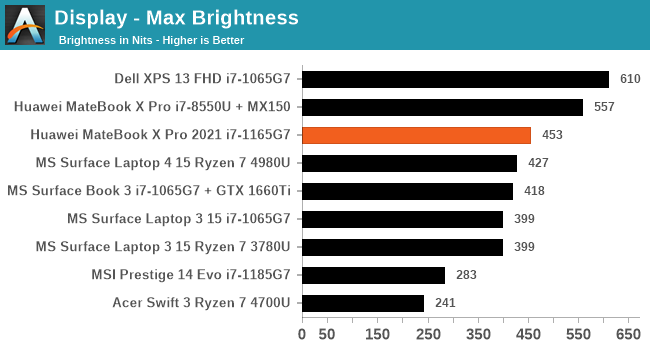
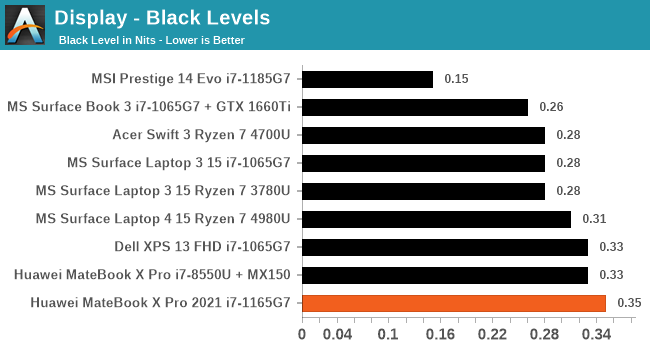

As for maximum brightness, we’re right on specification, however in our testing the black level is certainly higher than other devices in the market, which leads to a lower-than-advertised contrast ratio.
Battery Life
Taking advantage of the bigger-than-13-inch form factor, Huawei has equipped the MateBook X Pro 2021 with a 56 Wh battery, which is about 10-20% bigger than the 45 Wh batteries we see in the smaller size. Without the presence of a discrete GPU, one might argue that this battery should go for a long time, however the high-resolution display might prove to be an Achilles heel. Huawei’s documentation lists a 10 hour battery life for local video playback, which would be just enough for a long haul flight.
For our testing, we calibrate the display as close to 200 nits as we can (in this case, brightness set to 62), and progress through both a movie workload and a web workload. We would have also tested using PCMark’s battery test, however the test would always fail when video decoding, as mentioned previously.
It’s worth noting that Huawei lists the battery as 56 Wh (typical). Our battery reported 55.4 Wh when fully charged.
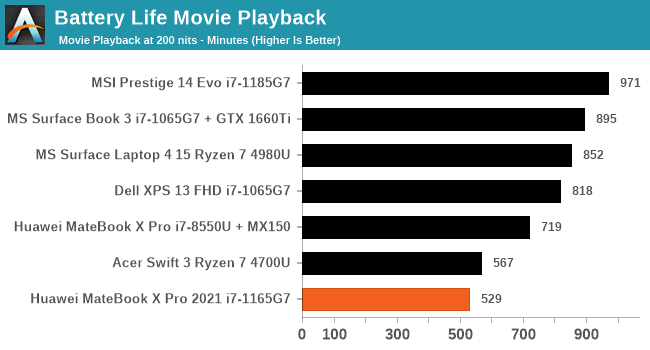
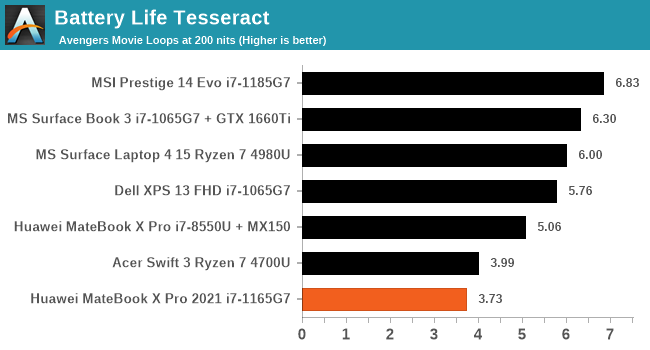
Our movie test at 200 nits is just below the 10 hour mark quoted, however Huawei seems to have done their testing at 150 nits, according to the website. 529 minutes is actually quite low compared to a number of laptops that the MateBook X Pro 2021 competes against.
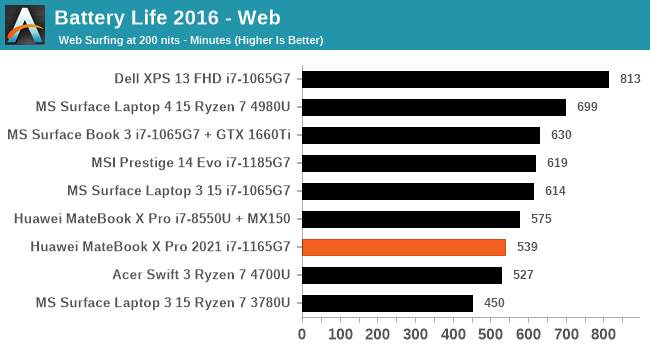
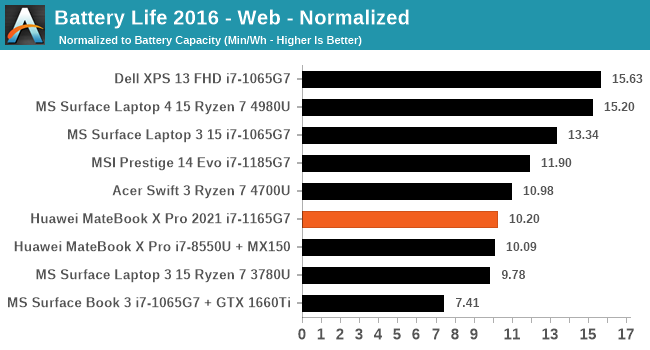
The web test does slightly better than our movie test, even though the screen is doing a lot more whites, but it isn’t having to process so much video. Normalizing for the battery capacity, we get 10.2 minutes per Watt-hour, which again isn’t a great result compared to the previous generation hardware or AMD’s offering.
Charge Time
Huawei ships the laptop with a 65 W charger with a Type-C port, and a C-to-C cable to connect it to the laptop. For our charge test, we discharge the battery down to 5% with a high powered workload, then down to 2% while on idle to cool it down. The system is then plugged it in, set on low power, with the screen still at 200 nits, and then monitored the charge level as reported as a function of time up until the reported charge no longer moved.
As well as our output report, I also put one of these in the loop. It showcased that the laptop was charging around 48-52 W constantly for the first 80 minutes or so, at 20 V / 2.5 A.
For our charge profile, we achieved:
- 2% to 10% charge in 7 minutes
- 2% to 65% charge in 60 minutes
- 2% to 90% charge in 87 minutes
- 2% to 100% charge in 110 minutes
Even though the charger is listed as 65 W capable, I didn’t see it ever go up to 65 W.
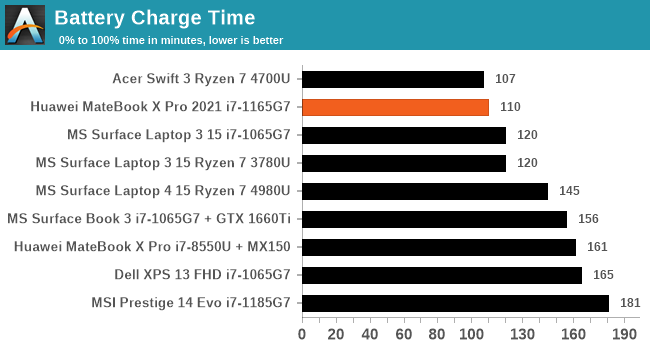


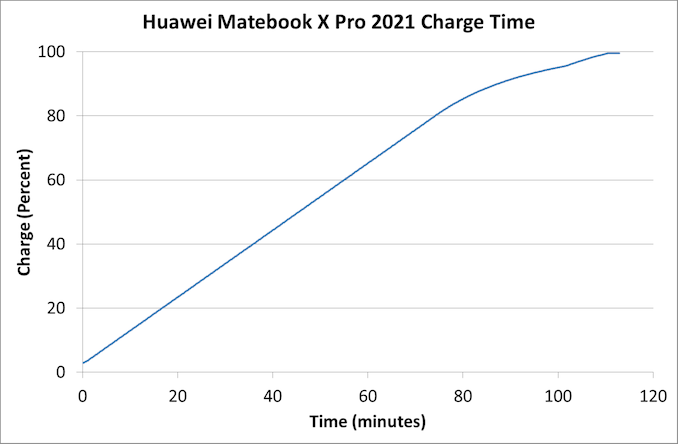








84 Comments
View All Comments
gijames1225 - Tuesday, September 28, 2021 - link
The MBA is the default laptop of this category for journalists. Very few other professionals go with a MBA. If they are hellbent on a Mac, they get a MacBook Pro of some size, and otherwise the default is a high-end machine from HP, Dell, or Lenovo.The MacBook Air is a computer for non-professionals or writers / students / journalists. That obviously leads to them having an outsized presence in tech reporting, but I've never seen a developer, graphic designer, or video editor rely on a MBA (even though you no doubt could in a pinch).
It sounds like you have a MacBook Air or at really, really love them, and that's fine; but that's not the default laptop for the overwhelming majority of the world.
skavi - Tuesday, September 28, 2021 - link
you appear to be forgetting about programmers.TheinsanegamerN - Tuesday, September 28, 2021 - link
Unless you are programming mac apps or iphone apps, the majority use windows laptops, sometimes with linux. The days of Macs being for professionals are over, largely thanks to apple themselves.lemurbutton - Tuesday, September 28, 2021 - link
Everyone in Silicon Valley uses a Mac, except for the finance department.Linustechtips12 - Wednesday, September 29, 2021 - link
i would label this more as "California people" as most down there do use MacBooks but its generally because they think windows just sucks because OOOHHHH APPLE GOOD PRODUCTSaolDan - Wednesday, September 29, 2021 - link
So true. California is apple land.vladx - Wednesday, September 29, 2021 - link
Here in Europe, less than 10% of programmers use a Mac so YMMV.The_Assimilator - Wednesday, September 29, 2021 - link
No, the only people who use Macs are the people who don't do any actual work. Sales, marketing, C-level execs.star-affinity - Saturday, October 2, 2021 - link
Not where I work…Most developers are on MacOS for both Android development and (naturally) iOS development.
Some Android developers are on Linux.
People need to stop the everything is black or white” thinking. You can do a lot if work in various business with a Mac. You can do a lot if work in various business with PC/Windows computer.
They both work pretty well together too, especially nowadays when there's so much ”working in the cloud” going on.
Illyan - Tuesday, September 28, 2021 - link
in the real world developers heavily use macs, dont know where you're getting this "the days of Macs being for professionals are over" idea from